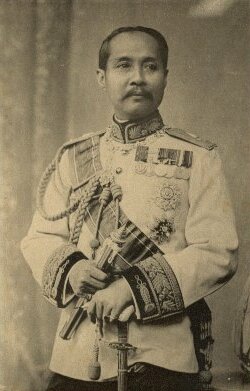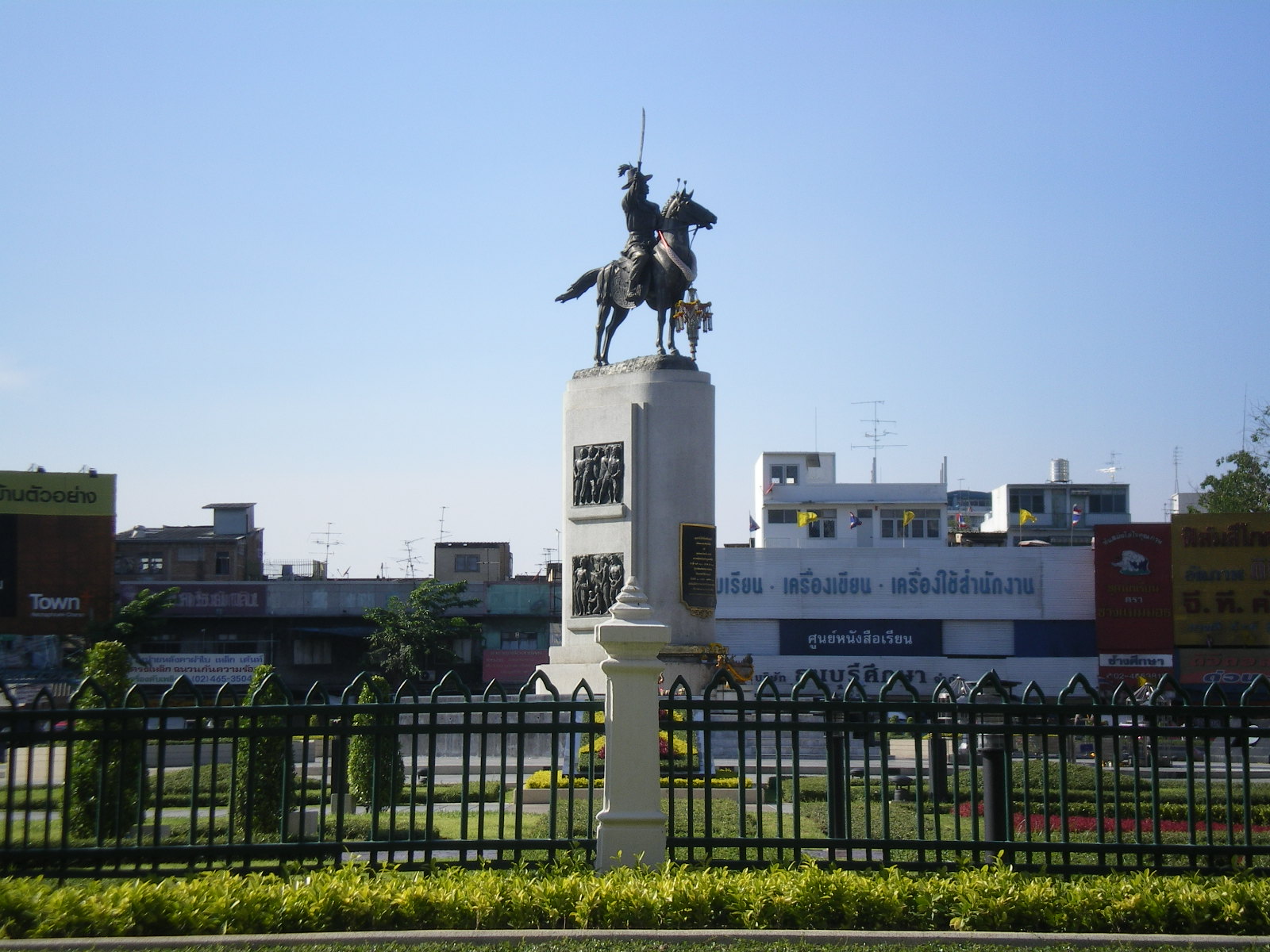|
Itsaraphap Road
250px, Itsaraphap Road in the phase of Chinorot Wittayalai School (left) and Royal Thai Navy Headquarters (right). Itsaraphap Road ( th, ÓĖ¢ÓĖÖÓĖÖÓĖŁÓĖ┤ÓĖ¬ÓĖŻÓĖĀÓĖ▓ÓĖ×, ) is a main road in Bangkok's Thonburi side (west bank of Chao Phraya River), it is also the location of the Itsaraphap MRT Station, the Blue Line extension station and the only underground station on the Thonburi side. It has a starting point at Lat Ya Junction in the area of Khlong San Subdistrict, Khlong San District, where it meets Lat Ya and Tha Din Daeng Roads then westward cuts across Ban Khaek Intersection, where it meets Prajadhipok Road in the areas of Hiran Ruchi and Wat Kanlaya Subdistricts, Thon Buri District, then spans Khlong Bangkok Yai canal on Charoenphat Bridge and into the area of Bangkok Yai District (this phase it also serves as a delineates line between Wat Arun and Wat Tha Phra Subdistricts) and cuts across Pho Sam Ton Junction, where it meets Wang Doem Road, as far as spans Khlong Mon an ... [...More Info...] [...Related Items...] OR: [Wikipedia] [Google] [Baidu] |
Bangkok Noi District
Bangkok Noi ( th, ÓĖÜÓĖ▓ÓĖćÓĖüÓĖŁÓĖüÓĖÖÓ╣ēÓĖŁÓĖó, ) is one of the 50 districts (''khet'') of Bangkok, Thailand. Neighboring districts are (from north clockwise) Bang Phlat, Phra Nakhon (across Chao Phraya River), Bangkok Yai, Phasi Charoen, and Taling Chan. History Bangkok Noi was established as an amphoe on 15 October 1915. Originally named Amphoe Ammarin, it was renamed on 11 July 1916 to Amphoe Bangkok Noi to match with the historical name of the area. It became a khet in 1972 when Thon Buri and Bangkok were merged. Later on 9 November 1989 the Bang Phlat district was created from four of Bangkok Noi's sub-districts, leaving Bangkok Noi with four remaining sub-districts: Siri Rat, Ban Chang Lo, Bang Khun Non, and Bang Khun Si. On 12 December 1991 a small part of Bang Phlat district was moved back to Bangkok Noi, creating the new Arun Ammarin sub-district. Symbols The district seals shows the head of the royal barge Sri Suphunahongsa. The slogan of the district is ''Resonant ... [...More Info...] [...Related Items...] OR: [Wikipedia] [Google] [Baidu] |
Taweethapisek School
Taweethapisek School ( th, Ó╣éÓĖŻÓĖćÓ╣ĆÓĖŻÓĖĄÓĖóÓĖÖÓĖŚÓĖ¦ÓĖĄÓĖśÓĖ▓ÓĖĀÓĖ┤Ó╣ĆÓĖ©ÓĖü) is located in Bangkok Yai District, Bangkok, Thailand, in the Thonburi area. The school was founded by King Chulalongkorn (Rama V) on 19 July 1895. It has facilities such as basketball and table-tennis as well as a 400-metre running track around the football field. As of 2013 there are about 3,000 students. Most of the students are Thai and mostly Buddhist, while other students follow other religions, including Hinduism, Islam, and Christianity. History Taweethapisek School was established on July 19, 1895 by King Rama V. To celebrate this special occasion, King Rama V wanted to establish a school in honor of his grandfather, King Rama II. He donated 2,000,000 baht and persuaded the royal members to donate to build the school at Wat Arun Ratchawararam, the royal temple of King Rama II. King Rama V named the school "Taweethapisek". In Thai, ''Tawee'' means twice or double and ''pisek'' means c ... [...More Info...] [...Related Items...] OR: [Wikipedia] [Google] [Baidu] |
Rajabhat University
The Rajabhat Universities (, ) mean normal universities in Thailand. They were formerly called ''Rajabhat Institutes'' and originally formed the teachers college system. In 2005, King Bhumibol Adulyadej collectively elevated them to be universities. Many provinces have oneŌĆöthere are 38 totalŌĆöand they are generally easier to gain admission to than the public universities (formerly the government universities). Most Rajabhat Universities offer graduate degrees, some even to the doctoral level. Enrollments have been shrinking. , students numbered 540,000, down from 600,000. These institutions are equivalent to British polytechnics that have become universities. They face a similar challenge of matching the prestige of older institutions. They were conferred the royal word ''Rajabhat'' to possibly shield them from criticism and help raise their status. Name The word "Rajabhat" is derived from the same origin as the Hindi, "Rajput" (from Sanskrit raja-putra, "son of a king"). In ... [...More Info...] [...Related Items...] OR: [Wikipedia] [Google] [Baidu] |
Wongwian Yai
Wongwian Yai, also spelled "Wong Wian Yai" or "Wongwien Yai" ( th, ÓĖ¦ÓĖćÓ╣ĆÓĖ¦ÓĖĄÓĖóÓĖÖÓ╣āÓĖ½ÓĖŹÓ╣ł, ; ), is a large roundabout (traffic circle) in Thonburi, on the west bank of the Chao Phraya River in Bangkok, Thailand, where the statue of King Taksin is situated. It overlaps between the four sub-districts of two districts, Bang Yi Ruea and Hiran Ruchi of Thon Buri with Somdet Chao Phraya and Khlong San of Khlong San in the centre of Bangkok, at the intersection of Prajadhipok/ Intharaphithak/ Lat Ya/ Somdet Phra Chao Taksin Roads. Nearby is Wongwian Yai Station, a historical commuter railway terminal to Maha Chai (local name of Samut Sakon provincial city) and Mae Khlong ( Samut Songkhram), a southwestern suburb of Bangkok. History The circle appearing on an issue of Thailand Illustrated in 1954 The circle was built following the Memorial Bridge (Phra Phutta Yodfa Bridge) opening on 6 April 1932, commemorating the 150th anniversary of the Chakri Dynasty and Bangkok C ... [...More Info...] [...Related Items...] OR: [Wikipedia] [Google] [Baidu] |
Taksin
King Taksin the Great ( th, ÓĖ¬ÓĖĪÓ╣ĆÓĖöÓ╣ćÓĖłÓĖ×ÓĖŻÓĖ░Ó╣ĆÓĖłÓ╣ēÓĖ▓ÓĖĢÓĖ▓ÓĖüÓĖ¬ÓĖ┤ÓĖÖÓĖĪÓĖ½ÓĖ▓ÓĖŻÓĖ▓ÓĖŖ, , ) or the King of Thonburi ( th, ÓĖ¬ÓĖĪÓ╣ĆÓĖöÓ╣ćÓĖłÓĖ×ÓĖŻÓĖ░Ó╣ĆÓĖłÓ╣ēÓĖ▓ÓĖüÓĖŻÓĖĖÓĖćÓĖśÓĖÖÓĖÜÓĖĖÓĖŻÓĖĄ, ; ; Teochew dialect, Teochew: D├¬n Chao; April 17, 1734 ŌĆō April 7, 1782) was the only King of Thailand, king of the Thonburi Kingdom. He had been an aristocrat in the Ayutthaya Kingdom and then was a major leader during the liberation of Siam from Myanmar, Burmese occupation after the Burmese-Siamese War (1765-1767), Second Fall of Ayutthaya in 1767, and the Taksin's reunification of Siam, subsequent unification of Siam after it fell under various warlords. He established the city of Thonburi as the new capital, as the city of Ayutthaya had been almost completely destroyed by the invaders. His reign was characterized by numerous wars; he fought to repel new Burmese invasions and to subjugate the northern Thai kingdom of Lanna, the Laotian principalities, and a threatening ... [...More Info...] [...Related Items...] OR: [Wikipedia] [Google] [Baidu] |
Sinlapa Watthanatham
''Silpa Wattanatham'' ( th, ÓĖ©ÓĖ┤ÓĖźÓĖøÓĖ¦ÓĖ▒ÓĖÆÓĖÖÓĖśÓĖŻÓĖŻÓĖĪ, ), known in English as ''Art & Culture'', is a Thai history magazine and a publishing imprint (trade name), imprint of Matichon Group. Founded by Sujit Wongthes in 1979, the magazine popularized Thai history and opened up the field, which had previously been restricted to academic circles, to mass consumption. Writers associated with the magazine, the most prominent of which include Sujit, Srisakara Vallibhotama and Dhida Saraya, mainly argued against the established narrative of Thai history which focused on Tai immigration from southern China and instead stressed the diversity of Thailand's cultural origins. References External links * 1979 establishments in Thailand History magazines published in Thailand Magazines established in 1979 Matichon Group Thai-language mass media {{DEFAULTSORT:Art and Culture ... [...More Info...] [...Related Items...] OR: [Wikipedia] [Google] [Baidu] |
Memorial Bridge, Bangkok
The Memorial Bridge ( th, ÓĖ¬ÓĖ░ÓĖ×ÓĖ▓ÓĖÖÓĖøÓĖÉÓĖĪÓĖÜÓĖŻÓĖĪÓĖŻÓĖ▓ÓĖŖÓĖ▓ÓĖÖÓĖĖÓĖ¬ÓĖŻÓĖōÓ╣ī) is a bascule bridge over the Chao Phraya River in Bangkok, Thailand, connecting the districts of Phra Nakhon and Thonburi. History The bridge opened on 6 April 1932, by King Prajadhipok (Rama VII) in commemoration of the 150th anniversary of the Chakri dynasty and the foundation of Bangkok, shortly before the Siamese coup d'├®tat of 24 June 1932. In English the bridge is commonly known as Memorial Bridge, however in Thai, it is most commonly known as Phra Phuttayotfa Bridge (ÓĖ¬ÓĖ░ÓĖ×ÓĖ▓ÓĖÖÓĖ×ÓĖŻÓĖ░ÓĖ×ÓĖĖÓĖŚÓĖśÓĖóÓĖŁÓĖöÓĖ¤Ó╣ēÓĖ▓), after King Phutthayotfa Chulalok (Rama I), the first king of the Chakri dynasty. The name is more commonly shortened as Saphan Phut (ÓĖ¬ÓĖ░ÓĖ×ÓĖ▓ÓĖÖÓĖ×ÓĖĖÓĖŚÓĖś) or Phut Bridge or Buddha Bridge (meaning: Bridge of Buddha). Construction of the bridge was started on 3 December 1929 by Dorman Long, Middlesbrough, England, under the supervision of Italian techni ... [...More Info...] [...Related Items...] OR: [Wikipedia] [Google] [Baidu] |
Prajadhipok
Prajadhipok ( th, ÓĖøÓĖŻÓĖ░ÓĖŖÓĖ▓ÓĖśÓĖ┤ÓĖøÓĖü, RTGS: ''Prachathipok'', 8 November 1893 ŌĆō 30 May 1941), also Rama VII, was the seventh monarch of Siam of the Chakri dynasty. His reign was a turbulent time for Siam due to political and social changes during the Revolution of 1932. He is to date the only Siamese monarch of the Chakri Dynasty to abdicate. Early life Somdet Chaofa Prajadhipok Sakdidej ( th, ÓĖ¬ÓĖĪÓ╣ĆÓĖöÓ╣ćÓĖłÓ╣ĆÓĖłÓ╣ēÓĖ▓ÓĖ¤Ó╣ēÓĖ▓ÓĖøÓĖŻÓĖ░ÓĖŖÓĖ▓ÓĖśÓĖ┤ÓĖøÓĖüÓĖ©ÓĖ▒ÓĖüÓĖöÓĖ┤Ó╣ĆÓĖöÓĖŖÓĖÖÓ╣ī) was born on 8 November 1893 in Bangkok, Siam (now Thailand) to King Chulalongkorn and Queen Saovabha Phongsri. Prince Prajadhipok was the youngest of nine children born to the couple. Overall he was the king's second-youngest child (of a total of 77), and the 33rd and youngest of Chulalongkorn's sons. Unlikely to succeed to the throne, Prince Prajadhipok chose to pursue a military career. Like many of the king's children, he was sent abroad to study, going to Eton Colle ... [...More Info...] [...Related Items...] OR: [Wikipedia] [Google] [Baidu] |
Siriraj Piyamaharajkarun Hospital
Siriraj Piyamaharajkarun Hospital (SiPH) () is a hospital operated by the Faculty of Medicine Siriraj Hospital of Mahidol University. It is located in Bangkok on the west bank of the Chao Phraya River, adjacent to Siriraj Hospital and opposite Thammasat University (Tha Phra Chan Campus). The hospital is catered to high-income patients, similarly to Thailand's private hospitals, with one of its aims being to generate revenue for the operation of Siriraj Hospital. History The Faculty of Medicine Siriraj Hospital, Mahidol University was transferred a piece of land adjacent to the Chao Phraya River from the State Railway of Thailand following the board resolutions since 2003 from the cabinet and State Railway of Thailand, and finally on 11 January 2010 with an area of 33 rai, 2 ngan, and 94 square wa (53,976 square meters). King Bhumibol Adulyadej graciously conferred Princess Sirindhorn to lay the foundation stone for the building part of the project 'Siriraj towards a top med ... [...More Info...] [...Related Items...] OR: [Wikipedia] [Google] [Baidu] |
Siriraj Hospital
Siriraj Hospital ( th, Ó╣éÓĖŻÓĖćÓĖ×ÓĖóÓĖ▓ÓĖÜÓĖ▓ÓĖźÓĖ©ÓĖ┤ÓĖŻÓĖ┤ÓĖŻÓĖ▓ÓĖŖ; ) is the oldest and largest hospital in Thailand. It is in Bangkok on the west bank of the Chao Phraya River, opposite Thammasat University's Tha Phrachan campus. It is the primary teaching hospital of the Faculty of Medicine Siriraj Hospital, Mahidol University. Description With a capacity of more than 2,000 beds and visited by more than three million patients per year Siriraj is one of the largest and busiest medical centers in Southeast Asia. The medical school accepts about 250 medical students and more than 100 for postgraduate residency training each year. Siriraj is the largest public hospital in Thailand. Thanks to its excellent reputation, its tertiary care unit is the referral center for all hospitals in Thailand. The logo of the Siriraj Hospital is the Naga curled into a shape of "ÓĖ©" (pronounce as "Sor-Sala"), the first Thai alphabet of the hospital name with the Royal Diadem on top of the Naga ... [...More Info...] [...Related Items...] OR: [Wikipedia] [Google] [Baidu] |
Thon Buri Railway Station
Thon Buri railway station ( th, ÓĖ¬ÓĖ¢ÓĖ▓ÓĖÖÓĖĄÓĖŻÓĖ¢Ó╣äÓĖ¤ÓĖśÓĖÖÓĖÜÓĖĖÓĖŻÓĖĄ) formerly known as Bangkok Noi railway station (ÓĖ¬ÓĖ¢ÓĖ▓ÓĖÖÓĖĄÓĖŻÓĖ¢Ó╣äÓĖ¤ÓĖÜÓĖ▓ÓĖćÓĖüÓĖŁÓĖüÓĖÖÓ╣ēÓĖŁÓĖó), is a railway station in Siriraj Sub-district, Bangkok Noi District, Bangkok. It is a class 1 railway station and is the current terminus of the Thon Buri Branch Line. Near the station is a railway depot that keeps five functional steam locomotives operable for four special occasions. Thon Buri station is the only station in Bangkok that has railway semaphore signals (although unused) still present on the station grounds. History Originally, the station's location was at Bangkok Noi railway station. It opened in 1903 as a terminus for all Southern Line services. The station was the site of the 0 km mark for the Southern Line. During World War II it was bombed by the Allies as it was a Japanese logistical centre. After the war, the station was rebuilt and was named ''Thon Buri'', opening in ... [...More Info...] [...Related Items...] OR: [Wikipedia] [Google] [Baidu] |

.png)



